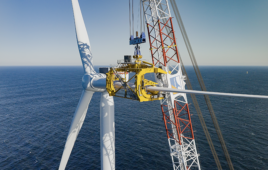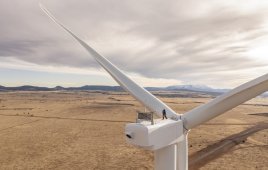A speaker at a supply-chain conference remarked that power from a wind turbines will have to compete power from natural gas. Hence, costs will have to come out of components. One way to lower turbine costs is with new manufacturing ideas and equipment. In the machine tool industry, manufacturers have responded with a variety of equipment. Three recent designs that will help, include a portable milling machine, one that allows complex gear hobbing in one setup, and abrasive waterjets.
The portable circular milling machine is said to expedite on-site machining of large flanges from 73.5 to 199-in. diameter. The manufacturer says the mill is capable of extremely tight flatness tolerances required for wind-tower flanges as well as a surface finish of 63Ra (1.6Rm). The circular mill can be configured for milling or single-point machining as well as grinding operations.
Circular mills also are used on assembly lines in wind-tower fabrications and in-field services to machine flanges to spec that may have warped in welding. Multiple mounting options are another feature. It includes ID/ OD or face-mounted configurations, and a tubular rigid chucking system with adjustable feet. These allow leveling the machine quickly and precisely in the flange for simple and speedy setup.
A special compact gear hobber may let shops generate splines, spur, or helical gears in one operation. An adjustable tool holder eliminates having to transfer rough gears on one machine to another for gear hobbing. To compensate for different types of grooves or pitches in splines and gears, users simply set a vernier dial to ± 20°. The machine’s a compact design lets it operate in most instances without interrupting neighboring tool stations.
The gear-driven gear hobber is built for heavy machining loads and delivers 45 Nm torque and speeds to 3,000 rpm for hobs or slotting saws up to 2.480-in. dia (63 mm).
Arbor diameters are available for all standard sizes for use of slotting saws and gear hobs. Changing tools takes just seconds by removing the yoke plate and sliding out the arbor. The base of the tool holder remains in its station.
Abrasive water jets, the third item in this short list, can cut a wide variety of materials, including composites (turbine blades) and metals such as aluminum, stainless and mild steel, and titanium with an accuracy of motion up to ± 0.003 inches (0.076 mm). A cutting head that tilts on one waterjet cutting machine is said to make a cost-efficient, productive jet-cutting center with a multi-axis accessory and a direct-drive pump.
Manufacturers say abrasives waterjets are well suited for precision machining of larger or multiple parts. One manufacturer says it product is equipped with a drive system, developed for abrasive waterjet machining to ensure high accuracy. The drive is enclosed inside coated steel covers, making it well suited for harsh environments and requiring little maintenance. A recent design allows faster traverse speeds than traditional drive systems that reduce processing times when machining multiple or nested parts.
Filed Under: Components





